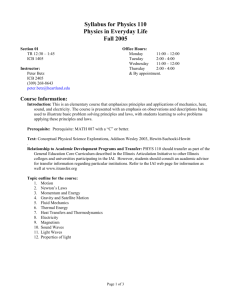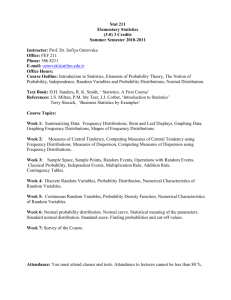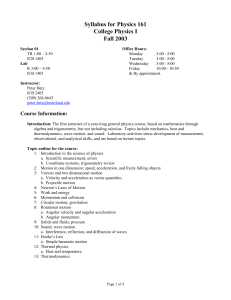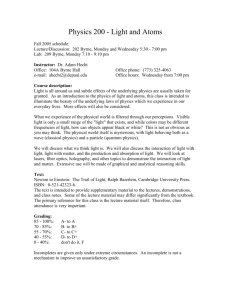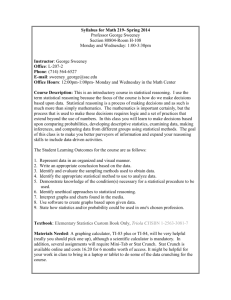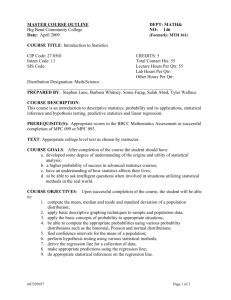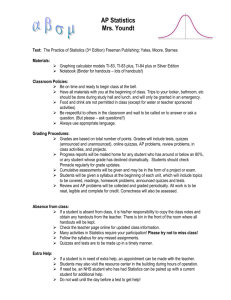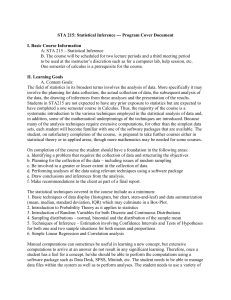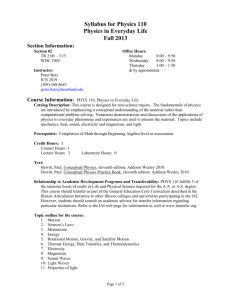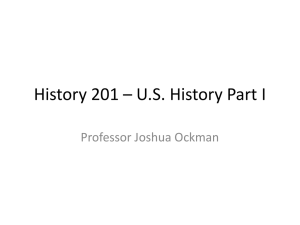math 141 betz - Heartland Community College
advertisement
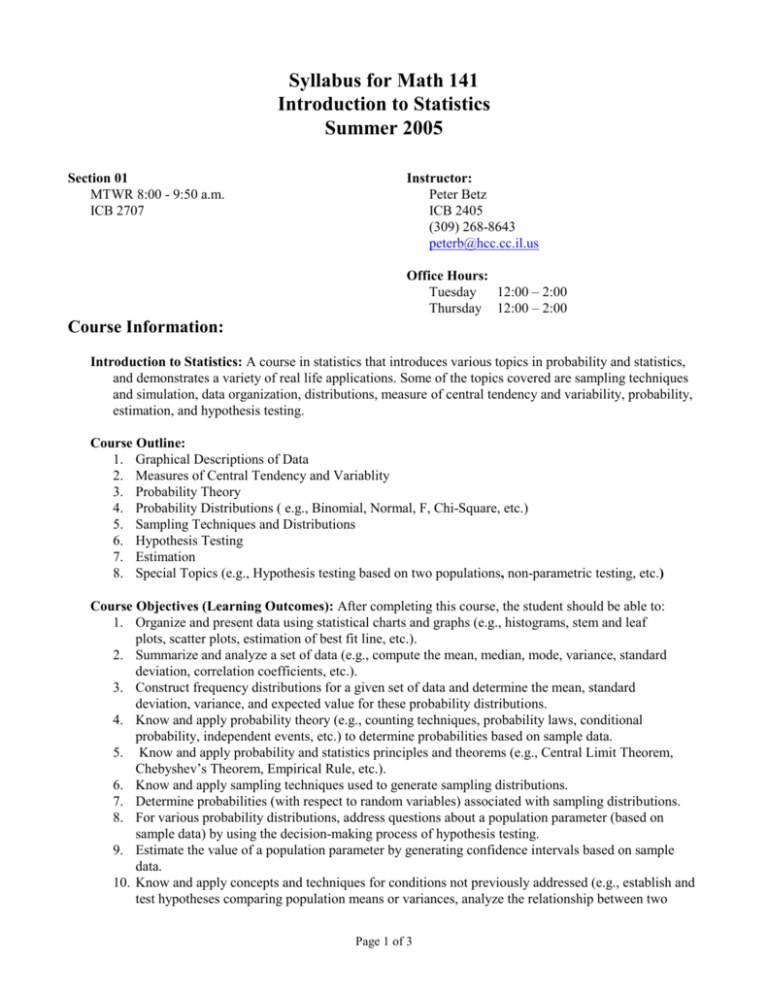
Syllabus for Math 141 Introduction to Statistics Summer 2005 Section 01 MTWR 8:00 - 9:50 a.m. ICB 2707 Instructor: Peter Betz ICB 2405 (309) 268-8643 peterb@hcc.cc.il.us Office Hours: Tuesday 12:00 – 2:00 Thursday 12:00 – 2:00 Course Information: Introduction to Statistics: A course in statistics that introduces various topics in probability and statistics, and demonstrates a variety of real life applications. Some of the topics covered are sampling techniques and simulation, data organization, distributions, measure of central tendency and variability, probability, estimation, and hypothesis testing. Course Outline: 1. Graphical Descriptions of Data 2. Measures of Central Tendency and Variablity 3. Probability Theory 4. Probability Distributions ( e.g., Binomial, Normal, F, Chi-Square, etc.) 5. Sampling Techniques and Distributions 6. Hypothesis Testing 7. Estimation 8. Special Topics (e.g., Hypothesis testing based on two populations, non-parametric testing, etc.) Course Objectives (Learning Outcomes): After completing this course, the student should be able to: 1. Organize and present data using statistical charts and graphs (e.g., histograms, stem and leaf plots, scatter plots, estimation of best fit line, etc.). 2. Summarize and analyze a set of data (e.g., compute the mean, median, mode, variance, standard deviation, correlation coefficients, etc.). 3. Construct frequency distributions for a given set of data and determine the mean, standard deviation, variance, and expected value for these probability distributions. 4. Know and apply probability theory (e.g., counting techniques, probability laws, conditional probability, independent events, etc.) to determine probabilities based on sample data. 5. Know and apply probability and statistics principles and theorems (e.g., Central Limit Theorem, Chebyshev’s Theorem, Empirical Rule, etc.). 6. Know and apply sampling techniques used to generate sampling distributions. 7. Determine probabilities (with respect to random variables) associated with sampling distributions. 8. For various probability distributions, address questions about a population parameter (based on sample data) by using the decision-making process of hypothesis testing. 9. Estimate the value of a population parameter by generating confidence intervals based on sample data. 10. Know and apply concepts and techniques for conditions not previously addressed (e.g., establish and test hypotheses comparing population means or variances, analyze the relationship between two Page 1 of 3 Syllabus for Math 141 Introduction to Statistics Summer 2005 variables to determine if there is a correlation between them, analyze data which does not satisfy parametric assumptions, etc.). Prerequisite: MATH 096 with a grade C or higher or placement. Text: Moore, David S. The Basic Practice of Statistics, 3rd ed., New York: W. H. Freeman and Company. Relationship to Academic Development Programs and Transfer: The course is intended for students who want an introduction to statistics, including experience in gathering and analyzing data. This course is also intended for students fulfilling 4 credit hours in Mathematics as partial fulfillment for completion of the A.A. Degree or the A.S. Degree. This course is NOT intended for students requiring a pre-calculus statistics course for a business major or for students majoring in mathematics. MATH 141 should transfer as part of the General Education Core Curriculum described in the Illinois Articulation Initiative to other Illinois colleges and universities participating in the IAI. However, students should consult an academic advisor for transfer information regarding particular institutions. Refer to the IAI web page for information as well at www.itransfer.org Grading Policy: Course grades: The grade you receive will be based on your exam scores, quiz scores, and final exam score. Note, the final is cumulative. 90% will guarantee a grade of at least A 80% will guarantee a grade of at least B 70% will guarantee a grade of at least C 60% will guarantee a grade of at least D Exams: Attendance is required at scheduled exams and the final exam. Exams will be 100 points each and the final exam will be 200 points. Final July 28 (R) during normal class time Make-up of Exams: Students will be allowed to make up a missed exam provided the student may provide a valid (to be determined by the instructor), verifiable, pre-approved (by instructor) reason for missing the exam. Students not meeting these criterion will receive a zero for the missed exam. Page 2 of 3 Syllabus for Math 141 Introduction to Statistics Summer 2005 Quizzes: You will have several quizzes throughout the semester. Quizzes will be worth 10 points each. Attendance quizzes will be taken when class starts (you must be present at 8:00 am to get credit). Make-up of Quizzes: Since your lowest quiz grades will be thrown out there will be no makeup quizzes! Attendance: Regular class attendance is an important part of educational success and is expected of all students. Students who miss class are responsible for the material covered that day, including obtaining the homework assignments and lecture notes. Attendance will not be a calculated part of your grade, but you are responsible for all announcements made in class. I also reserve the right to give unannounced quizzes. Required Writing and Reading: Students are expected to read the material in the textbook for each section studied. Required writings will be part of most assignments and exams as students explain how they found the solution, describe their solution graphically, and interpret their answer in the context of the problem. Homework: You are expected to do the assigned homework. It is expected that, at a minimum, 2 hours of outside work will be required for each hour in the classroom. This is a minimum. Some students will require more outside homework time. Also note that nothing precludes you from doing more than the required work. Extra work may be brought up by you in class or during office hours for questions and help. Incomplete grade: An incomplete grade may be given to a student who, by the withdrawal date, can reasonably be expected to pass the course. An incomplete grade may be granted only when justified by extreme circumstances (e.g., serious illness, accident, death or serious illness in the immediate family). Incomplete grades are not given for such reasons as unjustified failure to appear for the final examination. A written agreement that outlines the requirements to be met, must be signed by the instructor and the student. The agreed upon requirements must be completed no later than the end of the following semester. By the agreed upon date, the instructor will assign a grade or the incomplete will be changed to an `F’ if the requirements are not completed. Syllabus Disclaimer: This syllabus is subject to change. Page 3 of 3 Any changes will be announced in class.
